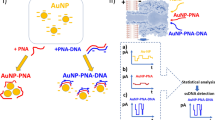Abstract
The recently developed bio-barcode assay for the detection of nucleic acid and protein targets without PCR has been shown to be extraordinarily sensitive, showing high sensitivity for both nucleic acid and protein targets. Two types of particles are used in the assay: (i) a magnetic microparticle with recognition elements for the target of interest; and (ii) a gold nanoparticle (Au-NP) with a second recognition agent (which can form a sandwich around the target in conjunction with the magnetic particle) and hundreds of thiolated single-strand oligonucleotide barcodes. After reaction with the analyte, a magnetic field is used to localize and collect the sandwich structures, and a DTT solution at elevated temperature is used to release the barcode strands. The barcode strands can be identified on a microarray via scanometric detection or in situ if the barcodes carry with them a detectable marker. The recent modification to the original bio-barcode assay method, utilizing DTT, has streamlined and simplified probe preparation and greatly enhanced the quantitative capabilities of the assay. Here we report the detailed methods for performing the ligand exchange bio-barcode assay for both nucleic acid and protein detection. In total, reagent synthesis, probe preparation and detection require 4 d.
*Note: In the version of the article initially published online, incorrect (non-final) versions of the article were posted in both the PDF and HTML formats. The errors have been corrected in all versions of the article.
This is a preview of subscription content, access via your institution
Access options
Subscribe to this journal
Receive 12 print issues and online access
$259.00 per year
only $21.58 per issue
Buy this article
- Purchase on Springer Link
- Instant access to full article PDF
Prices may be subject to local taxes which are calculated during checkout




Similar content being viewed by others
Change history
20 July 2006
In the version of the article initially published online, incorrect (non-final) versions of the article were posted in both the PDF and HTML formats. The errors have been corrected in all versions of the article.
References
Nam, J.M., Thaxton, C.S. & Mirkin, C.A. Nanoparticle-based bio-bar codes for the ultrasensitive detection of proteins. Science 301, 1884–1886 (2003).
Nam, J.M., Stoeva, S.I. & Mirkin, C.A. Bio-bar code–based DNA detection with PCR-like sensitivity, J. Am. Chem. Soc. 126, 5932–5933 (2004).
Mirkin, C.A., Letsinger, R.L., Mucic, R.C. & Storhoff, J.J. A DNA-based method for rationally assembling nanoparticles into macroscopic materials, Nature 382, 607–609 (1996).
Storhoff, J.J. et al. What controls the optical properties of DNA-linked gold nanoparticle assemblies? J. Am. Chem. Soc. 122, 4640–4650 (2000).
Storhofff, J.J., Elghanian, R., Mirkin, C.A. & Letsinger, R.L. Sequence-dependent stability of DNA-modified gold nanoparticles. Langmuir 18, 6666–6670 (2002).
Jin, R.C. et al. What controls the melting properties of DNA-linked gold nanoparticle assemblies? J. Am. Chem. Soc. 125, 1643–1654 (2003).
Lytton-Jean, A.K.R. & Mirkin, C.A. A thermodynamic investigation into the binding properties of DNA functionalized gold nanoparticle probes and molecular fluorophore probes. J. Am. Chem. Soc. 127, 12754–12755 (2005).
Demers, L.M. et al. Thermal desorption behavior and binding properties of DNA bases and nucleosides on gold. J. Am. Chem. Soc. 124, 11248–11249 (2002).
Thaxton, C.S. et al. A bio-bar-code assay based upon dithiothreitol-induced oligonucleotide release. Anal. Chem. 77, 8174–8178 (2005).
Demers, L.M. et al. A fluorescence-based method for determining the surface coverage and hybridization efficiency of thiol-capped oligonucleotides bound to gold thin films and nanoparticles. Anal. Chem. 72, 5535–5541 (2000).
Taton, T.A., Mirkin, C.A. & Letsinger, R.L. Scanometric DNA array detection with nanoparticle probes, Science 289, 1757–1760 (2000).
Cao, Y.W.C., Jin, R.C. & Mirkin, C.A. Nanoparticles with Raman spectroscopic fingerprints for DNA and RNA detection. Science 297, 1536–1540 (2002).
Oh, B.K., Nam, J.M., Lee, S.W. & Mirkin, C.A. A fluorophore-based bio-barcode amplification assay for proteins, Small 2, 103–108 (2006).
Stoeva, S.I. et al. Multiplexed detection of protein cancer markers with bio-barcoded nanoparticle probes, J. Am. Chem. Soc. (2006) DI: 10.1020/ja0613106.
Stoeva, S.I., Lee, J.-S., Thaxton, C.S. & Mirkin, C.A. Multiplexed DNA detection with biobarcoded nanoparticle probes. Angew. Chem. Int. Ed. Engl. 45, 3303–3306 (2006).
Frens, G. Controlled nucleation for regulation of particle-size in monodisperse gold suspensions. Nat. Phys. Sci. 241, 20–22 (1973).>
Acknowledgements
C.A.M. acknowledges HSARPA, NIH Pioneer Award, NIH NIAID, AFOSR, Doris Duke Charitable Foundation, NSF/NSEC and NCI. H.D.H: This work was performed while on appointment as a U.S. Department of Homeland Security (DHS) Fellow under the DHS Scholarship and Fellowship Program, a program administered by the Oak Ridge Institute for Science and Education (ORISE) for DHS through an interagency agreement with the U.S. Department of Energy (DOE). ORISE is managed by Oak Ridge Associated Universities under DOE contract number DE-AC05-06OR23100. All opinions expressed in this paper are the author's and do not necessarily reflect the policies and views of DHS, DOE or ORISE.
Author information
Authors and Affiliations
Corresponding author
Ethics declarations
Competing interests
The authors declare no competing financial interests.
Rights and permissions
About this article
Cite this article
Hill, H., Mirkin, C. The bio-barcode assay for the detection of protein and nucleic acid targets using DTT-induced ligand exchange. Nat Protoc 1, 324–336 (2006). https://doi.org/10.1038/nprot.2006.51
Published:
Issue Date:
DOI: https://doi.org/10.1038/nprot.2006.51
This article is cited by
-
Development of multiplex gold nanoparticles biosensors for ultrasensitive detection and genotyping of equine herpes viruses
Scientific Reports (2023)
-
Hydrogel-based molecular tension fluorescence microscopy for investigating receptor-mediated rigidity sensing
Nature Methods (2023)
-
DNA-framework-based multidimensional molecular classifiers for cancer diagnosis
Nature Nanotechnology (2023)
-
Modified gold nanoparticle colorimetric probe-based biosensor for direct and rapid detection of Mycobacterium tuberculosis in sputum specimens
World Journal of Microbiology and Biotechnology (2023)
-
Story of Pore-Forming Proteins from Deadly Disease-Causing Agents to Modern Applications with Evolutionary Significance
Molecular Biotechnology (2023)
Comments
By submitting a comment you agree to abide by our Terms and Community Guidelines. If you find something abusive or that does not comply with our terms or guidelines please flag it as inappropriate.



